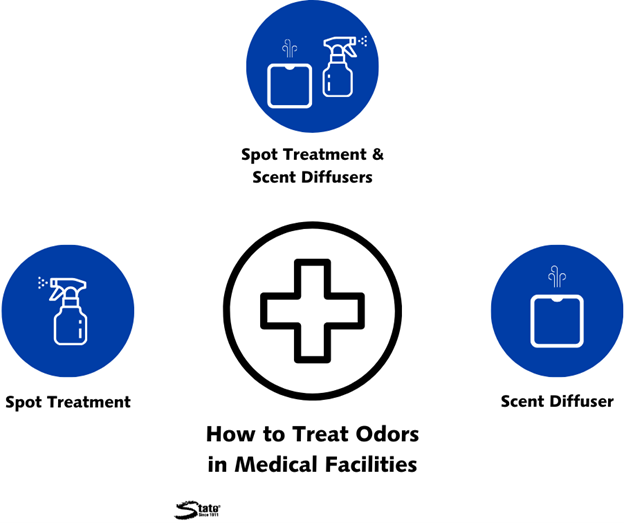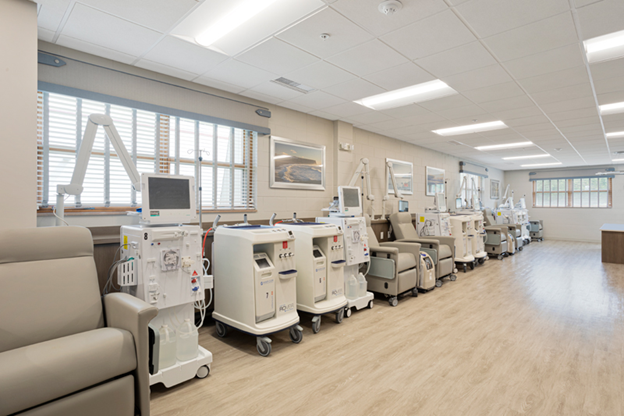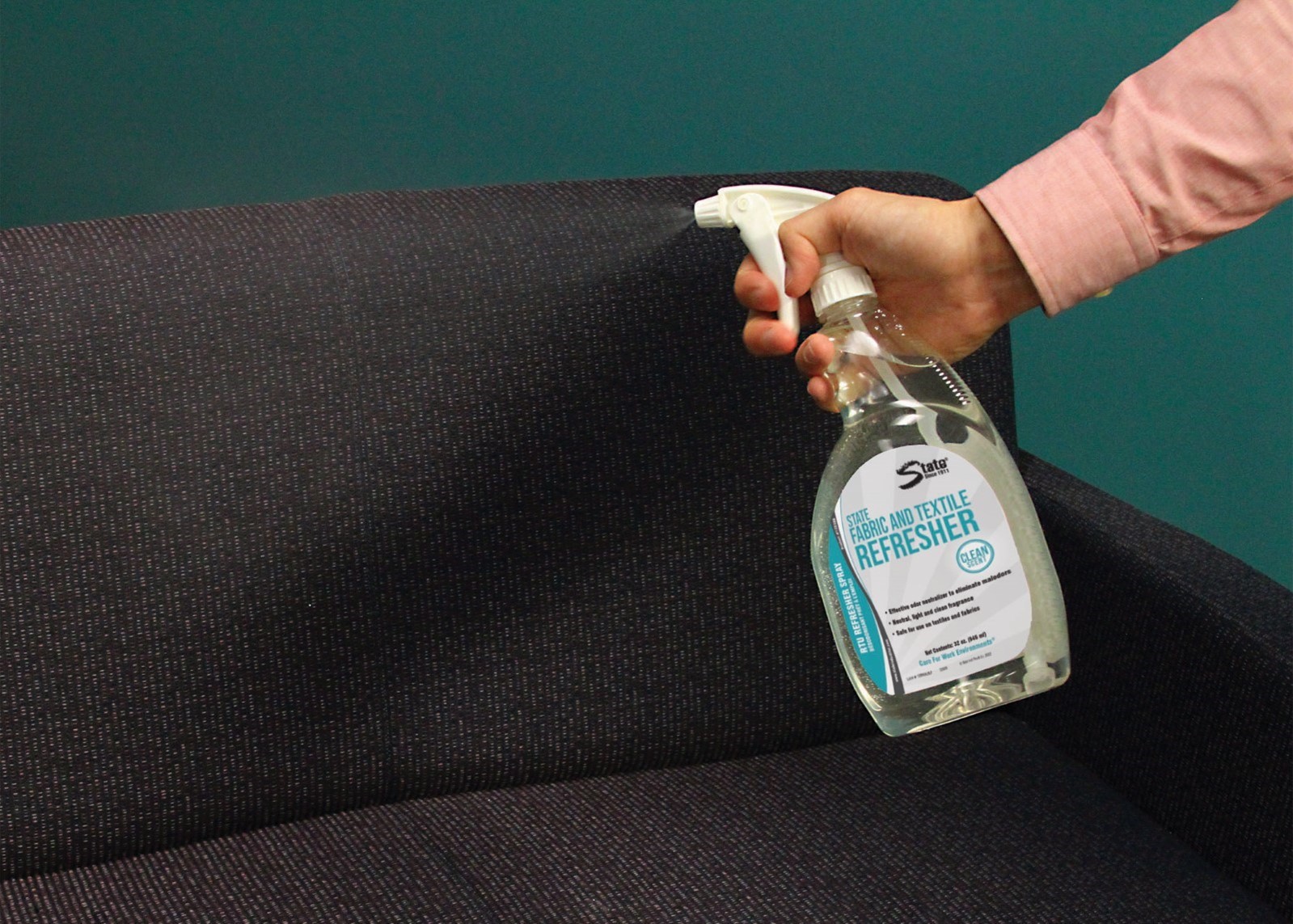How to Eliminate Odors in Medical Facilities
How to Eliminate Odors in Medical Facilities
Picture this: you’re on a hospital’s custodial staff. Every day, your team is tasked with cleaning everything in the facility—from the lobby to the cafeteria to the operating rooms. But it seems like no matter how much you clean, certain areas hold onto wretched odors.
Operating rooms smell sweaty and metallic—like body odor and old blood. The cafeteria smells like food sitting out—stewing and spreading through the hospital. And the lobby has its own problems, smelling like vomit and ineffective lemon cleaner ever since last flu season. You want to present your facility as clean and safe, but how do you do this in a setting that will always house an influx of sick people?
At State Chemical, we manufacture and distribute chemical solutions for various purposes, including odor control. Odors can add a sense of discomfort to any space, and visitors to medical facilities are already stressed out enough.
To help you determine how to eliminate the odors from your medical facility, we will explain common medical facility odors, different methods of treatment, and the end result for your facility. After reading, you’ll know the right method of odor control for you.
Common Causes of Odors in Medical Facilities
Medical facilities often deal with unique odor problems since they deal with bodily substances much more than, say, your average supermarket (or at least we hope that’s the case). The variety of these substances might vary from a hospital to a nursing home to a dialysis center, but at the end of the day, there are noticeably common odors across the medical field.
Body Odors
In just about any medical facility, body odors will probably be one of your primary odors. This can be sweaty-smelling bedding and furniture, a weird smell in the air, or something completely different. In any case, you and your visitors probably won’t enjoy it.
Imagine you run an assisted living facility where a potential resident’s family has come to take a tour. If they walk in and think it smells very strongly of sweat throughout the entire building, they probably won’t want their loved one to be staying there. These are the ways that odors can negatively impact your business.
Body odors often start out in fabrics and textiles, like furniture, upholstery, bedding, and carpeting. Sweat has a way of seeping into these materials and refusing to leave, making it easy for any type of fabric to become affected by odors. If this gets bad enough, however, your whole facility might take on this stench, and that’s when you’ll need to look into more extensive solutions.
Vomit/Waste Odors
Your medical facility will likely see a lot of vomit and waste in its lifetime, and unfortunately, these odors may linger even after you clean up the mess. As with body odors, these types of odors may cling to furniture, carpeting, bedding, or other objects, or they could even permeate the whole facility.
Suppose that you run a pediatric clinic. Unfortunately, a toddler vomited on the rug by the door last month, and despite thorough cleanings, the smell still seems to linger—the kind of smell so persistent you wonder if you’re imagining it. This probably isn’t making parents feel very confident about bringing their children in, so you’ll need to treat the odor at the source and possibly the facility as a whole if it’s bad enough.
Blood Odors
When you’re working in the medical field, you’ll more than likely be dealing with blood—and sometimes, a lot of it. Blood isn’t known for smelling particularly pleasant, and in large quantities, its potency can be widespread. For visitors, this can trigger traumatic memories and an overall sense of discomfort.
Say that you oversee the operations of a blood bank. One day, an employee mistakenly drops several bags of blood, which burst open and splatter across the floor. This, combined with past mistakes and constant blood collection, leaves a metallic smell in the air throughout the facility.
People who are going to give blood are already nervous. The ominous odor of blood as they walk through the door likely won’t calm their nerves.
Blood odors can be tied to specific items (e.g., carpeting), as with body and waste odors. However, it’s more likely that if your facility experiences blood odors, they’re probably connected more closely to certain rooms or even the entire building.
Dialysate Odors
A more unique odor that you may encounter is dialysate odors. This will only be an issue in dialysis centers and hospitals that perform dialysis treatments.
When dialysate is used in dialysis treatments, it flushes the waste and extra fluid from a person’s blood. This is a life-saving treatment for those experiencing kidney failure, but unfortunately, it can smell particularly bad. As with the previously mentioned odors, any kind of bodily waste entering the air isn’t going to have a positive impact on the smeller.
For these odors, you’ll want to look into facility-wide treatments (meaning scent diffusers), but instead of a typical spot treatment method, you also may want to explore drain care options. When dialysate enters the drain, it can build up and lead to drain odors and drain flies.
For drain-specific dialysis odor issues, read about the pros and cons of preventative drain maintenance.
Food Odors
Another common odor in medical facilities is that of food. This is usually from a facility’s cafeteria, whose smells may permeate through the whole building.
Imagine that you work in a hospital with a large cafeteria in a central location. After a while, the smells of chicken, soup, and broccoli seem to become a part of the building itself, and everywhere you go, it smells more like a cafeteria than a sanitary hospital.
This is a case where most likely, you’ll need to look into full-facility treatment options rather than spot treatment. Food odors tend to linger throughout entire spaces, and in your medical facility, this is especially likely as compared to odors tied to specific items.
Spot Treatment for Medical Facility Odors
For odors attached to small rooms or to areas like furniture, bedding, or carpeting, spot treatment is the best solution for you.
Spot treatment involves using ready-to-use odor eliminators to deodorize a smaller area or particular item. So, if you have body odors affecting your lobby furniture, you can turn to a fabric refresher. Similarly, if you have vomit odors affecting your rug, you can use a carpet odor eliminator. And if you have occasional waste odors affecting your bathrooms, you can use an odor-eliminating aerosol spray.
This method is perfect for targeting smaller or less consistent problem areas in your medical facility. If your situation falls into this category, spot treatment is the solution for you.
Scent Diffusers for Medical Facility Odors
Meanwhile, if your odors are widespread throughout your facility, scent diffusers are the solution for you.
Automated scent diffusers are machines that dispense an odor eliminator and a fragrance into a space on a programmable schedule. They can fragrance areas as small as an elevator or as large as an entire building, making them perfect for widespread, consistent odors.
Consider facility-wide body, waste, blood, dialysate, and food odors. None of these create a welcoming environment for guests, and none of these can be solved with a household air freshener. By investing in a fragrance system, odors will be automatically treated throughout your building as a whole, keeping it fresh for visitors and staff alike.
Determining Your Ideal Odor Control Plan
Your ideal method of odor control might involve one, both, or neither of these methods. How you treat your problem comes down to your individual facility.
For severe problems, we recommend both spot treatment and the use of an automated scent diffuser. This way, you can deal with targeted issues as they arise while also ensuring that the facility as a whole smells consistently clean.
Imagine that you run a nursing home where there is a strong body odor problem. Maybe it’s noticeable throughout the whole facility, but it’s particularly pungent in the lobby furniture. Here, you might want to use a fabric refresher to treat the furniture directly while also using an ambient scent diffuser to freshen the facility as a whole. This would be the most comprehensive solution to a multi-faceted problem.
Pay attention to where your facility’s odors are noticeable, their consistency, and where they’re at their worst. This will tell you a lot as far as where you should be focusing your energy.
The Outcome of Odor Control for Your Facility
When you treat your facility’s odors, you project a more professional image to patients and visitors. No one will feel positive about visiting their relative in a hospital that smells like blood, but they’ll be more trusting of a hospital that smells subtly like fresh linen.
Odor control and fragrancing are a means of brand building. What your visitors smell when they visit your location gives them a sense of how they feel about you. When that smell is hygienic, they’ll feel that much more positive about you.
Use the odor control method that makes the most sense for your facility, and you’ll see the results echoed in visitor satisfaction.
Learn What an Air Care Agreement with State Chemical Involves
Medical facilities work with sick individuals, and so they see their fair share of odors. Fortunately, there are a variety of odor control methods for every need, enabling your facility to maintain a clean, professional image.
To learn more about what an air care agreement with State Chemical involves, watch the video below.


















